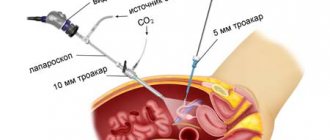The period in the first twelve weeks is recognized as early pregnancy. Bleeding in the early stages of pregnancy is a serious pathology and indicates the presence of changes that require urgent intervention from a specialist.
The volume of blood can vary - from spotting to massive bleeding. Sometimes, with heavy bleeding during pregnancy, scanty discharge is observed due to the retention of blood in the uterus between its walls and the placenta - a small volume of discharge may incorrectly reflect the pathological process. Therefore, you must immediately consult a doctor.
Causes of bleeding
During pregnancy, bleeding of any origin is considered a deviation from the norm and requires immediate medical intervention. Predisposing factors depend on the type of disease.
There are many reasons that can provoke such a violation:
- Heavy physical activity that causes tension in the muscles of the lower abdomen. In this case, the patient often does not notice fatigue until the first signs of impairment appear.
- Severe stress, which leads to the release of a large amount of substances into the blood that stimulate uterine contractions.
- Insufficient intake of vitamins, especially tocopherol, into the body. This vitamin is considered the most important for the health of the reproductive system, so during pregnancy a woman needs it very much.
- Infectious diseases of the vagina and cervix.
- Erosive changes in the mucous membrane of the cervix and vagina.
- Freezing of the fetus and the development of inflammation in the uterine cavity.
- Placental abruption of varying severity. In most cases, only a small area will peel off, but sometimes the peel will cause severe bleeding.
- Development of the fetus in the fallopian tube and its rupture during embryonic growth.
- A sharp change in hormonal levels, a decrease in the level of progesterone, which is responsible for reliable attachment of the fetus to the endometrium.
- Damage to small endometrial vessels during embryo attachment.
Other causes are less likely to cause bleeding. It is worth noting that each factor leads to the development of a certain type of disorder.
Possible diseases
Bleeding during early pregnancy occurs as a result of the development of one of several diseases.
Each of them is dangerous to the life of not only the fetus, but also the mother:
- Hydatidiform mole – a dangerous condition in which individual cells of the embryo grow into the thickness of the endometrium. In this case, pregnancy does not develop, and the bubbles gradually grow, which leads to prolonged and heavy bleeding. Additionally, the woman experiences a deterioration in her general condition and pain in the lower abdomen. A little later, headache, nausea, and vomiting appear.
Bleeding during pregnancy can be a signal of various diseases, for example, hydatidiform mole.
- Ectopic pregnancy is a condition in which the fertilized egg does not enter the uterus and does not attach to the endometrium, but remains in the fallopian tube, where it gradually develops. However, the tube is not able to stretch as much as the uterus, so usually at 5-6 weeks it ruptures, accompanied by bleeding. Additionally, the woman feels severe pain, weakness, and dizziness. Quite often she loses consciousness from painful shock.
- Placental abruption is one of the dangerous complications that is often observed in the early stages of pregnancy. The cause may be a lack of tocopherol, heavy physical activity, or stress. In this case, the woman initially experiences slight bleeding, the blood has a bright scarlet tint. Somewhat later, its quantity increases. If the detachment is minor, then after 1-2 days the discharge becomes dark red or brown, which indicates the gradual attachment of the placenta to the wall of the uterus.
- Frozen pregnancy is a common occurrence, which can also cause bleeding. Typically, such a disorder is associated with genetic abnormalities, serious injuries and stressful situations. It is worth noting that the discharge is dark in color and has an unpleasant odor; it is not abundant. A few days after freezing, the patient reports headache and nausea. Some women confuse this condition with toxicosis in the early stages, so they do not consult a doctor in a timely manner.
- Cervical erosion is one of the most common diseases among patients of reproductive age. During pregnancy, the uterus gradually stretches, so the cervical mucosa is also affected. Which leads to injury, erosion and bleeding. In this case, the amount of discharge is usually insignificant. Heavy bleeding is observed only when the erosive surface extends to the entire area of the cervical pharynx.
- Endometriosis is a common gynecological disease in which endometrial cells grow in unusual places, for example, in the fallopian tubes, ovaries and cervical canal. In advanced cases, lesions appear even in the abdominal cavity. After fertilization of the egg, it does not attach tightly enough to the inner layer of the uterus, so over time a detachment forms and bleeding develops.
It is worth noting that the discharge with endometriosis is scanty, dark red or burgundy in color. Additionally, the patient is bothered by pain in the lower abdomen and weakness. Typically, signs of the disease are present before conception and worsen after conception.
A sharp disruption of hormonal levels, a significant decrease in progesterone levels. In the female body, this hormone is produced by the adrenal cortex and also by the ovaries. When one or another organ is damaged, a sharp increase or decrease in indicators occurs.
An increase during pregnancy is a natural process, but a decrease is considered a deviation and can provoke bleeding as a result of the weakening of the position of the embryo in the uterus. Additional symptoms accompanying bleeding include weakness, irritability, and dizziness.
It is these diseases that most often provoke bleeding in the early stages. There are other deviations, but they are much less likely to cause deviation.
Corpus luteum deficiency
It is more often observed in the first trimester of pregnancy, less often in later stages.
It occurs due to insufficient production of progesterone, the pregnancy hormone, by the corpus luteum.
Causes
Usually not associated with a real pregnancy, but are hidden in problems with the health of the mother - for example, polycystic ovary syndrome.
What's happening
With a lack of progesterone, the tone increases and the growth of the uterus is disrupted - leading to rejection of the uterine mucosa, which is rich in blood vessels.
Manifestations
The intensity of bleeding is related to the degree of progesterone deficiency: the less hormone, the more pronounced the manifestations.
Usually, at the beginning, the bleeding is light and spotting, but then it intensifies.
Aching or cramping pain in the lower abdomen often appears, associated with increased tone of the uterus.
What threatens
Difficulty in implantation of a fertilized egg or spontaneous abortion.
Abdominal pain during pregnancyWhat are the types of pain that occur in the abdomen, and what can they signal? Read more |
Diagnostics
Bleeding during early pregnancy is diagnosed quite simply, since in most cases all the symptoms indicate one or another abnormality. Several methods are used that have the greatest information content.
| Method | Description | Venue and cost |
| General survey | Allows the specialist to obtain general information about the woman’s condition. It is important to determine the time of onset of bleeding, its nature and accompanying manifestations | Carried out in each medical institution, usually does not require payment from the patient |
| Examination of the patient | A gynecological examination on a chair helps to see visual changes in the cervix and vaginal mucous membranes. In this case, special instruments are used, and the manipulation is carried out as carefully as possible in order to prevent complications. | It is carried out in a gynecological office; in a private clinic the cost is approximately 200 rubles. |
| Clinical and biochemical blood test | The first analysis is necessary to assess the patient’s general condition, the second is to identify abnormalities in the digestive and cardiovascular systems. Blood is taken from a vein, the result is ready in 1-2 days, depending on the workload of the laboratory workers | It is carried out in any institution, the cost in a private clinic is 300-500 rubles. |
| Blood test to determine sex hormone levels | Blood is taken from a vein, and the levels of progesterone and estrogen are determined in the laboratory. The result helps to identify abnormalities and prescribe the necessary treatment | It is carried out in specialized laboratories that have all the necessary reagents. The price ranges from 600-00 rubles. |
| Ultrasound | The most effective diagnostic method, helping to identify even minor deviations in the organs of the reproductive system. Abruptions, ectopic pregnancy, endometriosis and other diseases can be detected using ultrasound | It is carried out in clinics equipped with appropriate equipment. The price for diagnostics is 300-400 rubles. depending on the institution |
Ultrasound examination is considered one of the most informative and effective diagnostic methods. It helps to identify any abnormalities in the reproductive system. However, all examination methods are used in combination to obtain the most accurate result.
When to see a doctor
Bleeding during pregnancy is a serious cause for concern, especially in the early stages. That is why a visit to a specialist should not be postponed.
It is important to contact a gynecologist at the first sign, who supervises the woman while carrying a child.
If the bleeding is acute and profuse, you should not wait until your appointment at the clinic. It is necessary to immediately call an ambulance, which will take the patient to the gynecological department.
Bleeding during pregnancy: should you tell your doctor?
Yes. Any bleeding during pregnancy should be reported to your gynecologist immediately.
Any vaginal bleeding before the 24th week of pregnancy is considered a potential risk of miscarriage. After 24 weeks it is called antepartum hemorrhage. Those who have a negative Rh factor should definitely consult a doctor within 72 hours after bleeding, as there is a suspicion that the baby’s blood may be mixed with yours. If mixing occurs, the mother's body may begin to produce antibodies against the child's Rh positive blood. Positive Rh is much more common than negative Rh. For the first pregnancy, mixing the blood does not have any consequences, but in subsequent pregnancies the body may decide that it needs to attack the unfamiliar matter with antibodies if the child is Rh positive again. Below are the most common causes of bleeding during pregnancy. Not all of them are scary and dangerous. During pregnancy, minor cramps and tugging sensations occur, and this is normal. But if bleeding is accompanied by severe pain and cramps, immediately seek medical help.
Prevention
After establishing the pregnancy period, a woman should carefully monitor her condition. It is important to normalize your diet and include foods in it. Rich in vitamins and minerals. This is considered one of the important ways to prevent bleeding as a result of vitamin deficiency. In addition, you should avoid heavy loads and stress.
A comfortable microclimate in the family is very important for a pregnant woman, especially in the early stages. Any unrest can cause detachment and other unpleasant complications. Despite the dangers of physical activity, a woman should not completely exclude it from her daily routine. It is necessary to ensure regular walks in the fresh air.
It is better to choose a moderate pace; if symptoms of fatigue appear, it is better to take a break. It is important to visit a doctor early, register and regularly visit a specialist who will note the growth of the fetus and the condition of the mother.
If deviations appear, the gynecologist will definitely prescribe additional diagnostics. Such preventive measures can minimize the risk of bleeding.
A few facts about bleeding during pregnancy
At different stages of pregnancy, every fifth woman experiences the phenomenon of bleeding. If you seek help in a timely manner, you can easily avoid a serious threat to your child. With the right approach, there is a chance not only to maintain the pregnancy, but also to give birth to a completely healthy baby.
It is worth considering the fact that the manifestation of bloody discharge from the genital tract during pregnancy can be one of the main signs of the development of a threatened miscarriage, as well as be the main symptom of early placental abruption or ectopic pregnancy. If the bleeding was provoked by just such reasons, there is a serious threat not only to the life of the child, but also to the expectant mother, and immediate intervention by an experienced doctor is required.
Today, the number of dangerous causes of bleeding is several times greater than non-dangerous ones. And only a specialist, after conducting a full examination of the pregnant woman, will be able to determine as accurately as possible the cause of the development of such changes.
Therefore, even with the slightest discharge from the genital tract, you need to be examined by your gynecologist. There is a possibility of brown discharge (in this case, the blood has had time to clot) or scarlet (in this case, fresh blood appears).
Treatment methods
There are several ways to stop bleeding of varying intensity. Drug therapy is considered the most popular and frequently used. However, sometimes it is allowed to take folk remedies.
Medications
Bleeding during early pregnancy in the vast majority of cases is treated in a hospital setting.
The standard scheme involves the appointment of the following funds:
- Dicynone is a hemostatic medication, produced in the form of a solution for intravenous or intramuscular administration in ampoules of 2 ml. The patient is prescribed a course of 10 days with the administration of 1 ampoule in the morning and evening. The drug helps stop bleeding, stimulates the formation of blood clots and increases the number of platelets in the systemic circulation. The product is quite effective; in case of heavy bleeding, the daily dosage is increased to 3 ampoules. Package price 10 pcs. is approximately 70 rubles.
- Tranexam is a stronger hemostatic agent that is used for heavy bleeding when conventional medications do not produce results. The patient is given 1 ampoule of medication intravenously per day. The duration of the course is usually no more than 5-7 days. The medicine is highly effective and almost always helps stop bleeding. The price of 1 ampoule of the product ranges from 30-50 rubles.
- Papaverine is an antispasmodic drug that is always prescribed for bleeding during pregnancy. The drug relaxes the smooth muscles of the uterus, which significantly reduces the amount of blood released. The patient is administered 2 ml of medication 3 times per day, the course duration is from 1 to 3 weeks. The price of 10 ampoules of the product is from 50 rubles.
- Utrozhestan is a hormonal drug in the form of tablets for oral administration. Contains a certain amount of progesterone necessary for the normal course of pregnancy and fetal development. The patient is prescribed from 1 to 3 capsules per day, depending on the degree of damage. Course duration is from 2 to 6 weeks. In some cases, the product is used throughout the entire gestation period. The price of a package of the drug is 500 rubles.
In some cases, antibacterial drugs are prescribed, but only if the pregnancy cannot be maintained and it is necessary to suppress signs of inflammation and prevent the spread of infection.
Traditional methods
During pregnancy, any self-medication can lead to complications, so experts are often negative when it comes to the use of folk remedies. Only some of them are approved for use in case of bleeding.
An infusion based on mint and lemon balm is considered the best sedative that reduces emotional stress. This medicine is used when bleeding is caused by severe stress.
It’s easy to prepare the composition:
- Separate 3 g of mint and lemon balm. It is better to take fresh leaves.
- Add 500 ml boiling water.
- Leave to infuse for 20 minutes.
- Filter the finished product.
Take 100 ml 3 times a day. The maximum duration of the course is 5 days. Linden decoction is an effective remedy that has a beneficial effect on the entire body and helps improve a woman’s condition. You can prepare the medicine from 5 g of dry raw materials and 500 ml of water. Cook the herb for at least 3 minutes. After infusing for 40 minutes. the product is ready for use.
You need to take 200 ml per day for a week.
Any of the products can be used only after consulting a doctor. Self-medication can provoke serious complications.
Premature placental abruption
May occur after 16 weeks of pregnancy or during childbirth.
Causes
Diseases of the tissue (kidneys, heart and blood vessels), malformations of the uterus (bicornuate, septum), insufficiency of the corpus luteum, fetoplacental insufficiency, gestosis/toxicosis, polyhydramnios during real pregnancy and others.
What's happening
Small hematomas (containing blood inside) form between the placenta and the wall of the uterus, merging with each other and peeling the placenta away from the wall of the uterus.
Manifestations
With a small detachment, the bleeding is not abundant. Damaged vessels can thrombose (a blood clot forms) and further placental abruption is stopped.
When detachment occurs over a large area, bleeding is usually profuse.
Detachment is accompanied by increased uterine tone. There are nagging pains in the abdomen and lower back, sometimes they are quite pronounced and resemble pushing.
What threatens
Blood flows poorly to the child - the delivery of oxygen and nutrients is disrupted.
There is a risk of developing heavy bleeding, which threatens the life of both mother and child.
Accumulated blood can serve as a substrate for infection and/or lead to premature rupture of the membranes.
Read more - Leakage of amniotic fluid. Signs and diagnosis
Hypertonicity of the uterus during pregnancy
Other methods
Bleeding during early pregnancy is quite difficult to treat. The only additional method of therapy is surgical intervention when there is no chance of maintaining the pregnancy.
Indications for intervention will be the following:
- Ectopic pregnancy.
- Bubble drift.
- Placental abruption, causing heavy and prolonged bleeding that cannot be stopped with medications.
- Multiple cysts of the ovaries and uterus.
- Toxicosis, which leads to complete exhaustion of the patient.
In this case, a forced termination of pregnancy is performed by curettage of the uterine cavity. The operation is performed under general anesthesia and lasts from 20 to 60 minutes, depending on the degree of neglect of the condition.
After successful manipulation, the recovery period lasts from 1 to 3 weeks. The patient is prescribed antibiotics and blood purifiers. Additionally, she has been taking sedatives and restorative medications for some time. Other methods are not used in the treatment of bleeding during pregnancy.
Reviews from women with a similar problem
This happened to me too at the beginning of my pregnancy. At 6 weeks, at 9 weeks and at 14 weeks she was admitted to the hospital. The first two times they applied it, but the third time the bleeding was as heavy as menstruation. I was prescribed Duphaston.
Mashutka
https://www.babyblog.ru/community/post/happypregn/1765953
Duration 3 weeks. I went for an ultrasound and they said everything was fine. In the evening, my stomach began to pull and my lower back began to hurt, and as a result I started bleeding with mucus, like during menstruation. I called the doctor and prescribed Duphaston and suppositories with papaverine.
Christmas tree
https://deti.mail.ru/forum/v_ozhidanii_chuda/beremennost/krovjanye_vydelenija_na_rannem_sroke/
My eldest daughter and I had a similar experience: a brown smear, a constant tug in the lower abdomen. The doctor said it was a threat and also prescribed Duphaston. I drank it until about 20 weeks. Don’t worry, the main thing now is not to overwork yourself, walk slowly, rest more, and, of course, no sex life. Afterwards everything went away and during the second trimester nothing hurt at all. The main thing is to set yourself up only for positive emotions. This will not affect the child in any way.
Natalia
https://deti.mail.ru/forum/v_ozhidanii_chuda/beremennost/krovjanye_vydelenija_na_rannem_sroke/
Possible complications
In the absence of proper and timely treatment, the patient will certainly develop complications. With prolonged bleeding, symptoms of anemia may appear. In addition, with bleeding caused by placental abruption, fetal development is disrupted and malformations may occur.
During an ectopic pregnancy, the most common complication is a rupture of the fallopian tube. At the same time, the patient’s life is in danger if she is not provided with timely assistance. Bleeding during the 10-12th week of pregnancy increases the likelihood of losing a large amount of blood, as well as the uterus.
The most severe complication of bleeding during this period is considered to be death. This occurs with an ectopic pregnancy, hydatidiform mole, or rupture of the uterine wall into the abdominal cavity. Rupture of multiple ovarian cysts is also considered a dangerous complication in the early stages of pregnancy.
Bleeding during pregnancy is a dangerous complication that threatens the life and health of the mother and child. In the early stages, such a sign becomes a cause for concern and requires immediate examination followed by treatment.
Article design: Ilchenko Oksana
The dangers of bleeding during pregnancy
In some cases, bleeding from the vagina during pregnancy can cause a rather strong feeling of anxiety in the expectant mother. The fact is that the manifestation of such bleeding in the early stages can lead to quite serious complications, which include not only ectopic pregnancy, but also the threat of spontaneous miscarriage, as well as the development of dangerous oncological formations.
Such bleeding may indicate that there are varicose veins in the blood vessels of the external genitalia, the presence of a dangerous infection of the vagina, as well as certain pathologies of the cervix, which may be severe and require immediate medical intervention.
One of the most dangerous complications of vaginal bleeding is the possibility of spontaneous miscarriage. At the very beginning of this condition, bleeding begins, which may be insignificant and not accompanied by any painful sensations; sometimes the girl does not experience any discomfort at all. However, such bleeding can continue for quite a long time, and at the very end sometimes very severe pain appears.
A dangerous condition such as an ectopic pregnancy can also provoke bleeding from the vagina. One of the negative consequences of the development of an ectopic pregnancy, if it is not diagnosed in time, can be rupture of the cervix, and in the most severe cases, a threat to the woman’s life develops.
It is very important to remember that complications of this kind can carry quite a serious danger and there is a need for immediate consultation with an experienced specialist, especially if the bleeding that occurs is accompanied by even minor discomfort.
The doctor conducts a full examination of the pregnant woman, after which he prescribes an ultrasound examination. Taking into account the obtained test data, he will be able to determine the presence of inflammation in the vagina, which as a result led to the onset of bleeding. Taking into account the peculiarities of the course of pregnancy, the doctor will have to convince that there is absolutely no threat of miscarriage.











